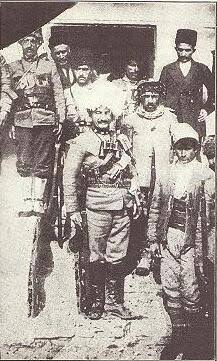| Urmia clashes | |||||||
|---|---|---|---|---|---|---|---|
| Part of the occupation of Northwestern Iran of the Persian campaign (World War I) | |||||||
 Agha Petros (with white Cossack hat) waiting for the Persian mullah's white flag's of surrender | |||||||
| |||||||
| Belligerents | |||||||
| |||||||
| Commanders and leaders | |||||||
|
|
| ||||||
| Strength | |||||||
| Less than 1,000[1] | Unknown but larger than the Assyrians[1] | ||||||
| Casualties and losses | |||||||
| Least at 80[2] |
| ||||||
The Urmia clashes (9–10 February 1918) or the Urmia revolt was a series of clashes in the city of Urmia between the Assyrian Volunteers led by Agha Petros and Malik Khoshaba against the city mayor Irshad Homayun and his supporters, including General Arshad el Moolk. This would be caused by the Russian withdrawal from their territories in Qajar Iran due to the Russian Revolution.
- ^ a b c d Werda 1924.
- ^ a b Ismael 1964, p. 91.